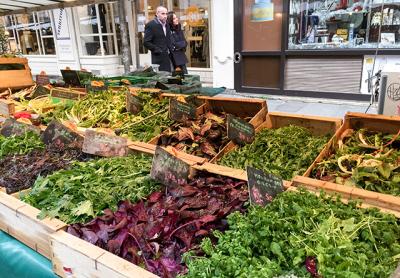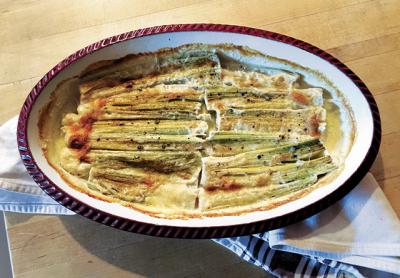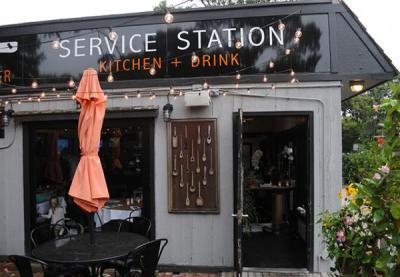Seasons by the Sea: We’ll Always Have Paris!
Seasons by the Sea: We’ll Always Have Paris!

It began with the invitation that couldn’t be refused: “Would you and your friends like to come to Paris for Thanksgiving?” Hot diggity dog, yes, please!
There would be five in our traveling group — my childhood friend Dicky, his wife, Beth, their daughter, Alice, my son, and myself. We all sprang for the extra legroom in coach class. To me this was to be a historical family trip. Dicky’s grandparents and my grandparents had lived in Paris and were the best of friends. Dicky’s mother and my mother had also lived in Paris and were best friends throughout their lives. Dicky is one of my best friends, and now here we were, taking our children to Paris, a fourth-generation pilgrimage. We went equipped with video cameras and the addresses of our ancestors. We never used the former, nor sought out the latter. But, boy, did we eat!
The terrorism alert from Homeland Security for Americans traveling abroad over Thanksgiving was somewhere between high and severe, so traveling with the most precious of cargos, our children, may have seemed foolhardy, but this was Paris.
We arrived on Wednesday morning in a jet-lagged stupor. After stumbling around the perimetere of the Pompidou Center, we took our chances for lunch at a tiny bistro called Le Chat Zen. It was pretty good. We got omelettes and lentils with sausage. We returned to our friend’s house for an afternoon of serious napping before we ventured out for one of the best meals we were to enjoy on the whole trip.
Chez George is one of the oldest and best bistros and was beloved by Julia Child. Framed mirrors all around, brass railings, lacy curtains, uniformed waiters, and tables so tightly strung together they have to be pulled out for patrons to slip through to sit against the wall. I began my meal with one of my favorite salads, celery remoulade — simply julienned celery root bound in a mustardy, creamy vinaigrette. The most memorable dish of the evening (and the whole trip) was a smoked herring salad ordered by our host. I’ve had many variations of herring (creamed, pickled, you name it) and care for none of them. But this was a mellow, warm, and slightly oily assemblage of a few fillets with potatoes, onions, and carrots. As at many bistros and brasseries, the servers simply put a huge dish down in front of you and you serve yourself as much as you like. Beware this generosity when the chocolate mousse comes around! We continued the meal with beef filets in brandy sauce, sole meuniere, frisée salad, and more. A glorious tarte tatin (upside-down apple tart) completed the meal before we trekked the mile or so home.
On Thursday morning I pitched in by stringing beans for our evening feast for 16 people. But not before gorging on a special pastry called praluline, basically a brioche studded with hot pink candied almonds and hazelnuts. After wandering the streets for hours we had lunch at Le Bouledogue, another tiny, charming cafe-brasserie in the neighborhood. Named for a family of bulldogs that lived on the premises, Le Bouledogue now has one last dog standing, or more like snoozing and snuffling, with the occasional indignant bark at his owner. This is another delightful aspect of Parisian restaurants, dogs are welcome inside, health department concerns be damned. Here we ate salmon tartare, steak tartare, poached leeks, cod on a bed of buttery smashed potatoes, and another version of that ethereal smoked herring salad.
The cheap and cheerful Beaujolais Nouveau had just come out, so for about $4 we were able to enjoy a few glasses of hat. Which brings me to the prices. Without a doubt, every single meal was cheaper than a cheap meal where we live. I mean, even cheaper than a burger at LT Burger or ribs from Townline BBQ or a sandwich from Mary’s Marvelous. Granted, we weren’t dining at any fancy restaurants, but the reverse sticker shock was heartening.
After an afternoon of more walking (we averaged six to eight miles a day, thank goodness, because I consumed every frite in sight), we required a little snack of street crepes, prepared on a huge cast-iron disc and customized with fillings like Nutella, strawberry jam, or just some good French butter.
Our Thanksgiving meal was another memorable feast prepared by Tom in a kitchen so small you couldn’t even fit two people in it. A turkey ballotine had been stuffed with bread and paté de campagne, the string beans were adorned with sautéed chanterelle mushrooms, Brussels sprouts were dotted with lardons, and a mysterious and silky puree turned out to be a combination of carrots, potatoes, celery root, and creme fraiche. For dessert Tom had made pumpkin pie and his partner, Mike, had gotten some merveilleux crunchy meringues filled with whipped cream and topped with chocolate shavings.
Early Friday morning we fortified ourselves with small baguettes filled with ham, cheese, and butter before we explored a once-a-year flea market-brocante looking for bits and bobs to take home. I found a sterling silver cocktail shaker for a mere $25, not discovering a crack in the lid until I got home. That’s cool; it still works. An aged hippie who knew Jim Morrison during his brief time living in Paris sold me some brass flatware. Lunch was another classic spot, Chez Janou, where we had a risotto made with farro and sea scallops, fish soup, octopus salad with roasted peppers, head-on shrimp with a basil-flecked rice, and an intriguing salad of tomatoes, green beans, a poached egg, and roasted chestnuts.
For dinner at Brasserie Balzar we indulged in foie gras, choucroute garnie, roast chicken, crabmeat with avocado and grapefruit salad, bone marrow, and onion soup.
Saturday was our last day and you may be wondering, “No museums? D’Orsay? Louvre? Picasso?” Well, we walked around all of them but couldn’t bear the long waiting lines. And besides, museum time would have cut into our grazing activities. To me, every pastry shop and fish store and even grocery stores were worthy of oohing and aaahing and photo taking. We lunched at Le Procope, one of the oldest restaurants in Paris, where we enjoyed oysters, smoked salmon with blinis, creamy spinach raviolis, chicken, and sole.
For our last supper we opted for a brand-new Vietnamese restaurant in the Marais called Hanoi. We were ready for crunchy vegetables, highly spiced food, and less cream. We had spring and summer rolls, mushroom dumplings, chicken with lemongrass and chiles, and pho.
The only mementos and gifts I came home with are all food related: small jars of Amora mustard for my brothers, flaky cookies and chive crackers for friends, a few small tins of duck and goose foie gras for whomever.
We killed time at the airport by gorging on our last croissants at Fauchon. I slipped the butter pats into my bag so I’d have a little breakfast-treat memory upon our return.
The first thing I did when I got home was trot over to Harbor Market in Sag Harbor to visit Paul Del Favero. He gets a delivery from Russ and Daughters every week and I asked him to include some smoked herring in the next shipment. I promised that if my experimentation with a recipe for that exquisite salad is a success I would share it with him.
Four full days in Paris was enough. Our children enjoyed and appreciated every aspect of it, especially the food and scenery. Every now and then we would toast our good fortune, give thanks, and remind ourselves of this historical trip, the fourth generation of dear family friends returning to the stomping grounds of our expat ancestors.
Click for recipes





